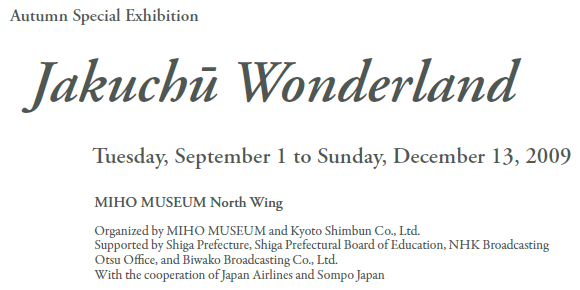
Japanese painting underwent an unprecedented blossoming during the mid-Edo
period, in the eighteenth century. In the Kyōhō era (1716–1736), the lifting
of the ban on Western books by Shogun Yoshimune, the importation of new
Chinese Ming and Qing-dynasty painting styles, as well as the creative
energy, which the modern scholar Fujioka Sakutarō (1870–1910) described as a
“reformation of old customs,” led to a rise in new painting talent from
among the burgeoning merchant class. In 1716, the artist Ogata Kōrin died in
Kyoto; the same year, the preeminent painter of the merchant class, Itō
Jakuchū (d. 1800), was born. During this period, the movement of realistic
sketches from nature—led by intellectual painters such Maruyama Ōkyo
(1733–1795)—became popular. Jakuchū also studied and fervently sketched
flowers, birds, and animals from life but through his meticulous and
detailed flora and fauna, he created a fantastical world separate from
reality.

In contrast to his colorful elaborate works, Jakuchū also produced monochrome ink paintings with quick, abbreviated brushstrokes. From his subjective view erupted a wild, uninhibited realm with the innocence of a child’s painting. Such creations were also products of Jakuchū’s imagination that resonate with our modern sensitivity and that has attracted much attention in recent years.

This exhibition presents the recently discovered pair of six-fold screens Whale and Elephant, for the first time in public, as well as other Jakuchū masterpieces from both domestic and international collections. Also featured will be contemporaneous individualistic artists of Kyoto and Osaka, such Ike no Taiga (1723–1776), Yosa Buson (1716–1783), Soga Shōhaku (1730–1781), Maruyama Ōkyo, and Katsu Jagyoku (1735–1780), who painted unique, large-scale works.
In contrast to his colorful elaborate works, Jakuchū also produced monochrome ink paintings with quick, abbreviated brushstrokes. From his subjective view erupted a wild, uninhibited realm with the innocence of a child’s painting. Such creations were also products of Jakuchū’s imagination that resonate with our modern sensitivity and that has attracted much attention in recent years.
This exhibition presents the recently discovered pair of six-fold screens Whale and Elephant, for the first time in public, as well as other Jakuchū masterpieces from both domestic and international collections. Also featured will be contemporaneous individualistic artists of Kyoto and Osaka, such Ike no Taiga (1723–1776), Yosa Buson (1716–1783), Soga Shōhaku (1730–1781), Maruyama Ōkyo, and Katsu Jagyoku (1735–1780), who painted unique, large-scale works.
|
Works will be rotated during the exhibition. |
1 Pair of Cranes, MIHO MUSEUM
